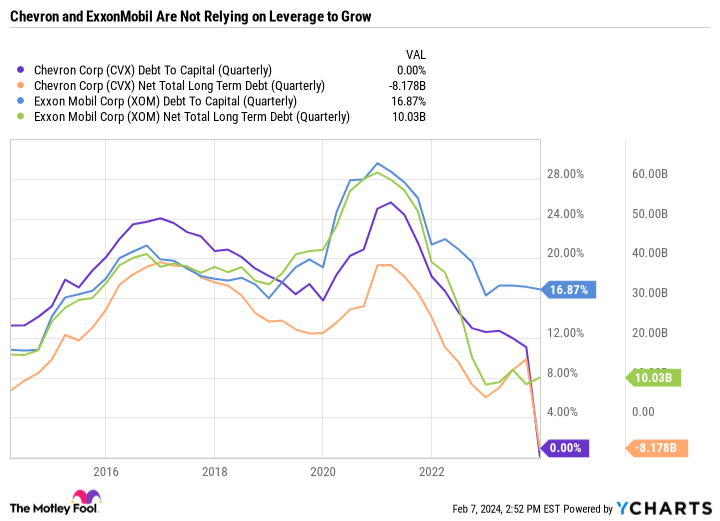The U.S. Energy Information Administration (EIA) just gave energy investors a vote of confidence for the coming years. In its short-term energy outlook published on Feb. 6, the EIA said, “Although we expect crude oil prices will rise into the mid-$80/barrel range in the coming months, we expect downward price pressures will emerge in 2Q24 as global oil inventories generally increase through the rest of our forecast.” But the EIA doesn’t expect prices to fall by that much.
Its full-year Brent crude oil forecast is $82.42 per barrel in 2024 and $79.48 in 2025. If that forecast is even close to correct, a lot of U.S. exploration and production companies are going to do very, very well. Majors like Chevron (NYSE: CVX) and ExxonMobil (NYSE: XOM) are two straightforward choices.
For investors looking for even higher yields, Brookfield Renewable (NYSE: BEPC) (NYSE: BEP) and household appliance company Whirpool (NYSE: WHR) are worth a look.
Here’s why all four high-yield dividend stocks are worth buying now.
A new paradigm for big oil
Daniel Foelber (Chevron/ExxonMobil): The modern-day oil major is catering to a different kind of investor than decades ago. After getting burned by downturn after downturn, not to mention the drastic underperformance of the energy sector relative to the market over the last decade, investors are demanding stability and surefire returns. In other words, better cost management, more resilience during downturns, less leverage on the balance sheet, and a stable and growing dividend.
Chevron and ExxonMobil have answered the call and are giving all of that (and then some) to shareholders. Both companies reported phenomenal results on Feb. 2 — proving that they can thrive when Brent crude oil prices are around $80 per barrel.
Perhaps the simplest way to see how these businesses have improved is to look at their leverage, as evidenced by the debt-to-capital ratio and the total net long-term debt position.
As you can see in the chart, Chevron and Exxon have very little net debt. They are funding their operations, future investment, and sizable capital return programs (buybacks and dividends) with operating cash flow.
The test going forward will be to not overexpand. ExxonMobil’s deal with Pioneer Natural Resources and Chevron’s deal with Hess look like smart long-term moves. And best of all, they were funded with stock, not cash.
If you tuned into the recent earnings calls, it’s very clear that the management teams of both companies recognize they can’t run these businesses like levered-up regional exploration and production companies, but rather, that investors in the oil patch gravitate toward the majors for their diversification across the value chain, their dividends, and their relative stability.
All told, it’s been a wake-up call for Chevron, and to a larger extent Exxon, in recent years. Both companies are in a good spot. And as long as they don’t start getting complacent and start over-levering again, these stocks should continue to be rock-solid passive income plays.
Brookfield Renewable is a green energy powerhouse that can charge up investors’ passive income machines
Scott Levine (Brookfield Renewable): While there are likely a variety of reasons why investors may be attracted to Chevron and ExxonMobil, one of them is likely the lower-risk nature of their businesses since they are industry leaders. The same thing can be said about Brookfield Renewable, which includes ample solar, wind, and energy storage assets in its portfolio. Providing investors with a supercharged 5.4% forward dividend yield, Brookfield Renewable is undeniably an appealing option for income investors at the moment.
Although high-yield dividend opportunities are compelling, savvy investors know they can also be risky. It’s not uncommon for companies to sacrifice their financial well-being to placate investors with hefty distributions.
With regard to Brookfield Renewable, however, this is hardly the case. The company reported a 7% year-over-year increase in funds from operations (FFO), resulting in Brookfield Renewable generating a record $1.67 per share in funds from operations — enough to cover the $1.35 it returned to investors in the form of dividends.
Besides the company’s recent performance, the future looks bright as well. Brookfield Renewable plans on raising its distribution by about 5% to 9% annually, representing a circumspect approach since it forecast 10% FFO-per-unit growth from 2023 through 2028.
Whirlpool’s 6.3% dividend yield is worth a look
Lee Samaha (Whirlpool): As long as interest rates remain relatively high, the U.S. housing market will be under pressure, and as long as the housing market is under pressure, so will discretionary spending on Whirlpool’s household appliances.
There’s no way around that fact for Whirlpool investors. Indeed, management’s outlook for 2024 is for flat like-for-like sales growth and flat earnings before interest and taxation (EBIT) margin in 2023. Moreover, its sales momentum appears to be deteriorating as management was forced to pull forward promotional activity (at the expense of profit margins) to try to reduce inventory.
It’s not a great outlook. Then again, that’s why the stock trades at less than 8 times what Wall Street analysts have penciled in for earnings in 2024 and has a 6.3% dividend yield.
However, Whirlpool isn’t just a deep-value stock; management is actively improving the underlying business. Around $800 million of costs were taken out in 2023, and management plans to take out an additional $300 million to $400 million in 2024.
In addition, Whirlpool is on track to combine its low-margin European business with a subsidiary of Arcelik in creating a new company, of which Whirlpool will own 25%. The deal will improve Whirlpool’s overall margins and allow it to focus on its core U.S. market alongside growth markets like Latin America.
Meanwhile, if and when the Federal Reserve starts cutting interest rates, Whirlpool’s end markets will improve. This makes Whirlpool an attractive stock for income-seeking investors who can tolerate some near-term risk.
Should you invest $1,000 in Chevron right now?
Before you buy stock in Chevron, consider this:
The Motley Fool Stock Advisor analyst team just identified what they believe are the 10 best stocks for investors to buy now… and Chevron wasn’t one of them. The 10 stocks that made the cut could produce monster returns in the coming years.
Stock Advisor provides investors with an easy-to-follow blueprint for success, including guidance on building a portfolio, regular updates from analysts, and two new stock picks each month. The Stock Advisor service has more than tripled the return of S&P 500 since 2002*.
*Stock Advisor returns as of February 5, 2024
Daniel Foelber has no position in any of the stocks mentioned. Lee Samaha has no position in any of the stocks mentioned. Scott Levine has positions in Brookfield Renewable. The Motley Fool has positions in and recommends Brookfield Renewable and Chevron. The Motley Fool recommends Brookfield Renewable Partners and Pioneer Natural Resources. The Motley Fool has a disclosure policy.
If You Like Chevron and ExxonMobil, Then You Will Love These 2 High-Yield Dividend Stocks was originally published by The Motley Fool








